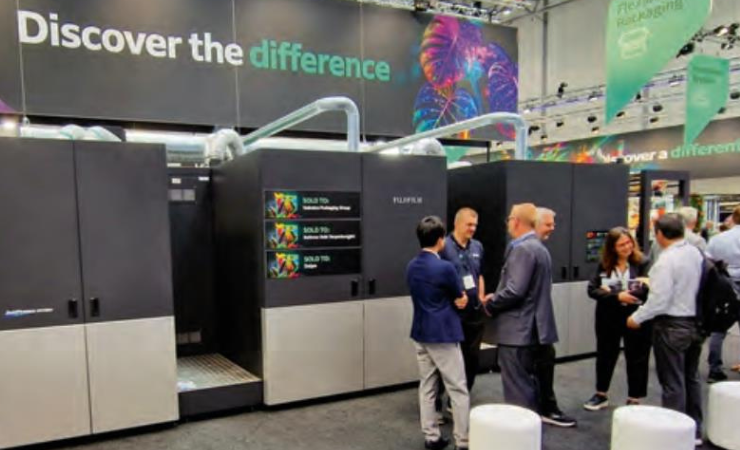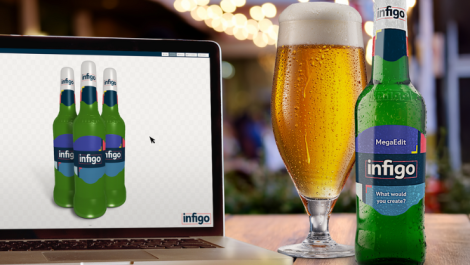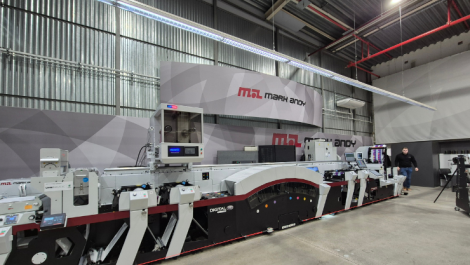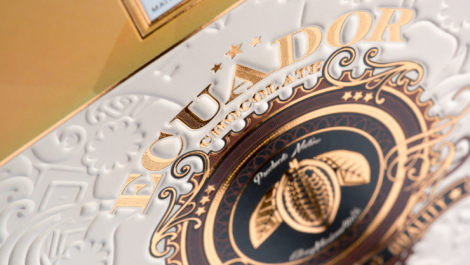drupa 2024 certainly showcased inkjet technology, and new high-performance presses means inkjet is increasingly competitive for all categories, comments Sean Smyth.
While some say it was the inkjet drupa (again – and there were 300+ exhibitors showing some form of inkjet technology) I think 2024 was the software drupa – linked with real attempts to be more sustainable. Labels and packaging were to the forefront, and after many years of incremental improvements in press speed, quality and reliability the vendors were largely focussing on end-to-end workflow. Digitisation is changing business models and processes from enquiry to job management through the factory to despatch while automating administration. But there was a lot of inkjet activity there, with corrugated, cartons, flexible packaging, metal and rigid plastics taking the box seat.
The mainstream suppliers had been briefing their developments for some time so there were few ‘Wow, I didn’t expect that’ moments, but it was great to see the touted systems actually printing at the promised speeds on the stands. The link between EFI and PackSize was jaw dropping, right size corrugated boxes beautifully printed in UV and delivered on-demand. EFI now has some 65 Nozomi machines in the field after the launch in 2016. This development will be very useful for e-commerce warehouses and distribution centres keen to personalise boxes for customers they know.
Productivity at its finest
At the show they also announced a water-based ink version with the Nozomi 14000AQ and a smaller version configured for meal sheets, the Nozomi 12000 MP, these developments are likely to spur further installs in more applications.
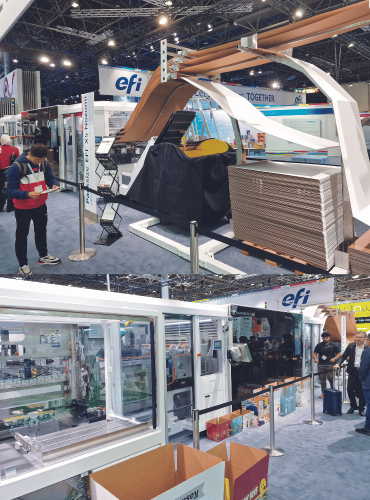
Input and output from the EFI Nozomi/Packsize system for on-demand corrugated box printing in an on-demand box maker
EFI was next to Landa booth (where Benny was in excellent form in every one of the beautifully choreographed shows telling the Nanography story). It is impressive to watch inkjet printing 11,200 B1 sheets per hour. This is more productive that the majority of equivalent sheetfed litho presses currently installed that may boast a higher top speed but lose time at make-ready. Even more impressive, however, was hearing the fabulous testimonials from the growing number of customers extolling the business benefits with several multi-press installations operating successfully. Landa said they now have 62 installs with cartons accounting for about a third of the machines and half installed during the last year as Landa’s dream is finally being realised. K&B Durst is a little behind, reporting a third sale as the company finalises the two beta VariJET 106 machines – one of these at Swiss converter Schelling AG, who also bought an early Landa press.
The innovative AlphaJET B1 press was on the Konica Minolta stand. This combines inkjet printing with coating and embellishment, there is the potential to include laser or mechanical cutting, presenting the machine as a print factory. The other inkjet carton machine on show was on Bobst’s stand, the webfed all-in-one model that incorporates inkjet printing with flexo units and coating/foiling/die-cutting in a single pass. This was presented as a concept, but they already have six machines operating in the field.
Some of the updated B2 sheetfed inkjet machines, from Ricoh, Fujifilm, Konica Minolta and Komori are used for cartons, while Canon’s version, the varioPRESS iV7 is under development. A version will be sold by Heidelberg as the FireJET 75, with a speed of 8700 B2 sheets per hour, significantly above competing B2 systems. The flat paper path and architecture making it straightforward to scale up for cartons. Canon took some analysts to their Venlo site in the Netherlands where we saw their development press and it is impressive. Canon included a dedicated labels and packaging sector on their stand including a model of a corrugated press they are working on, interestingly featuring robotic sheet loading and unloading. The new inkjet label press, the LabelStream LS2000 uses Canon’s new thermal printheads developed in Japan, with food safe water-based inks to boost the sustainability angle. They also showed a multi-pass toll-fed inkjet printer, the Colorado, configured as a packaging factory with a jumbo roll loader, cutter and output stacker. The idea is to replace litho lamination, the printed top liner sheets will be laminated to finished boards and converted into trays and boxes.
Barberán had the biggest inkjet machine that I saw at the show. The JetMaster was housed inside covers larger than many company booths. This modular UV single-pass inkjet press can print sheets up to a maximum width of 1890mm. The feeder can be used for other substrates including metal and carton board suggesting a move into other packaging applications at this large format. They also had a single pass inkjet web press printing décor paper and flexible packaging is on the horizon. This expansion of applications around a core proven technology Inkjet flexible packaging is a current hotspot.
Screen and Fujifilm showed off their flexible packaging inkjet solutions, Fujifilm with the FP790 machine sporting three ‘Sold To’ stickers after a couple of days at the show and further sales were announced.
Screen displayed just a print unit and K&B displayed samples from their RotaJet press at their booth. PCMC launched their ION hybrid flexo-inkjet machine on the BW Converting stand, where Winkler & Dünnebier were showing their next generation of inkjet light e-commerce package printers. On a small booth ink manufacturer Kao showed off a new water-based inkjet ink for Memjet printheads for flexible packaging that does not require any priming for films and includes the first reasonable opaque white I have seen.
Utilising collaboration
Uteco announced a partnership with SmartJet, an Italian developer with a binding agreement for a takeover. Comexi showed a video link to its Spanish headquarters where they were showcasing the full colour inkjet press as a concept. W&H also had an inkjet concept press at their Lengerich demo centre, taking some prospects there during the show to explore inkjet and analogue technology first hand. Guangzhou Pulisi showed a medium web UV inkjet machine for flexibles. Think Laboratories did not have a machine, but they showed off samples from their first presses installed at Japanese gravure manufacturers. Think Laboratory is a Japanese company supplying gravure equipment into the flexible packaging sector. They showed the results from the FXIJ inkjet flexible packaging press which they have two installs at gravure facilities in Japan, and a demo press in Europe. They also presented comparative prints of inkjet and gravure shows how Think Laboratory have managed to replicate the results from Japanese gravure converters which are amongst the most quality conscious of any print across the world.
Asian manufacturers were showing off their inkjet capability, single and multi-pass printers for labels, cartons, flexibles and corrugated where Hanglory and WonderJet are already selling single-pass corrugated postprint machines into the west through Tonbridge based GTS Europe.
A newcomer to digital packaging is Riso, renowned for their low-cost document printers, who showed the Integlide, featuring Toshiba Tec printheads. This is a full colour system to print onto finished corrugated boxes on conveyors, either in sideways or downward mode with a maximum 310mm width. Seiko had an upward jetting unit designed to allow reverse print of corrugate post-print for two-sided boxes.
So there was a lot to see and take in. There was a lot of packaging and label activity with inkjet very much to the fore. The maturing of software with workflow broadening to include automation and connectivity with business process development and new routes to market. Combined with new high-performance presses means inkjet is increasingly competitive for all categories of labels and packaging going forward as users exploit new business models.

